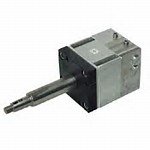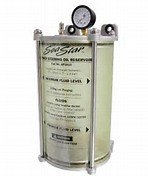SeaRow,
And others with Hynautic steering systems. Here's a PDF of the manual, it's easier to read than what I can do copying my old well used manual. It is a PDF I suggest you download and keep. I strongly recommend you follow the bleeding procedure to the letter. It makes the job much easier and it goes a lot faster.
http://boatsteer.com/assets/Hynautic_1987.pdf
My comments on Hynautic:
In my opinion it's a high quality system with a long service life and still supported by SeaStar. Keep in mind I am not a hydraulic steering systems design engineer. I've just been around them for more years than I care to admit. As I understand the design of the system the basic concept is no different than any other hydraulic system. Helm pump(s) and autopilot pump move the fluid one way or the other causing the ram to move and turn the rudders. Air in the system causes troubles, a little air makes the system soft and less than positive. A lot of air will cause failure. Air gets in from leaks or sloppy fill and bleed procedures.
Hynautic has added a pressurized reservoir that can be placed lower than the helm pump(s) and autopilot pump. I see some advantages to this.
- Once you have most of the air out of the system it will be self purging for small amounts. Some hydraulic systems can take a lot of effort and a long time to work all of the air out leading to less than positive control.
- The system is sealed from the atmosphere keeping moisture in the fluid to a minimum.
- Larger boats with longer runs need an expansion tank to handle volume changes with temperature. Some boats use the upper helm for that purpose. Larger boats will need a reservoir open to the atmosphere above the uppermost helm.
- A quick glance at the reservoir on your daily checks will show any change in pressure beyond normal changes due to temperature variations or level alerting you to leaks in the system.
My comments on the fluid to be used:
There has been discussion on other threads about the fluid to use. As always lots of opinions, some backed up by facts. I decided to go with MIL spec H-5606 oil rather than "boat hydraulic steering fluid". The former is available for $29 a gallon, the latter $29 a quart.
The manual calls for Hynautic's own fluid. Or a quality MIL spec H-5606 fluid. The reservoir label on my system simply says MIL spec H-5606 fluid. MIL spec
H-5606 is a military specification for aircraft hydraulic oil. To lose control of an aircraft due to hydraulic fluid problems is fatal. It's got to be good enough for a boat's steering system.
If you decide to go the H-5606 route I found two versions available at the local aircraft service shop. Quarts that are non resealable for single use throw away any extra and selling for nearly as much as the boat fluid. Gallons that are resealable and sell for $29. According to the owner and lead tech of the shop there is no difference in the fluid, just the packaging and intended use. I bought the gallons and will keep the extra tightly sealed in a dry place. I'm confident it will be good enough for topping up should that be required.






